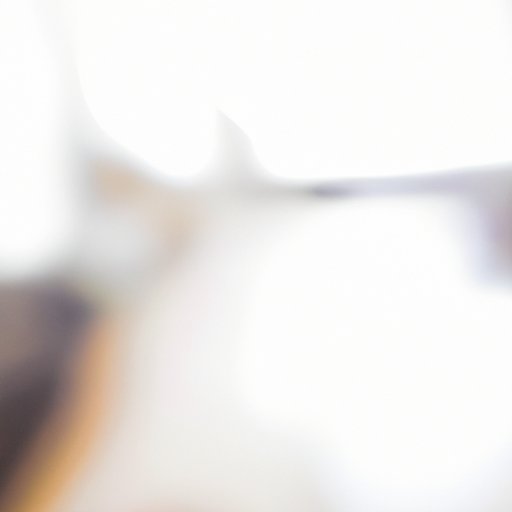
Introduction
Do you ever look at a photo you took only to find that the distracting background ruins the whole image? Sometimes, we can’t avoid having an unwanted background, but there is a solution – blur it! Adding a background blur can make your subject stand out and give your photos a professional and polished look. In this article, we will walk you through a step-by-step tutorial on how to blur the background of a picture using Photoshop or any other photo editing software, as well as discussing the factors that affect background blur and how to achieve a natural-looking effect.
How to Blur the Background of a Picture
The first step to blurring the background of a picture is to open your image in the photo editing software of your choice. Next, follow these steps:
- Select the subject of your image using any selection tool such as the lasso, marquee, or pen tool.
- Create a copy of the image with the background removed.
- With the copy layer selected, go to the filter menu, then select blur. The Gaussian blur filter is the most commonly used filter for blurring the background of an image.
- Adjust the slider until the background is appropriately blurred.
- Save your changes and export your image.
Remember to use a small and soft-edged brush to blend the edges of your selection for a more natural-looking effect. Don’t forget to save your changes as a different file or layer.
Factors Affecting Background Blur
The level of background blur in a photograph is influenced by several factors such as aperture, focal length, distance to the subject, and sensor size. Adjusting these settings will help you achieve the desired effect in your image. Here’s how each setting affects the background blur:
- Aperture: A wider aperture (low f-number) creates a shallower depth of field, resulting in creamy, blurry backgrounds.
- Focal length: A longer focal length can create more blur because it magnifies the background.
- Distance to the subject: The closer the subject is to the camera, the more blurred the background becomes.
- Sensor size: A larger sensor creates a shallower depth of field, blurrier background or foreground.
Experimenting with these settings can help you create different kinds of background blur. For instance, a small aperture is effective in blurring the background while keeping the entire subject in focus. Moreover, a longer focal length is useful in blurring the background, making it ideal for portrait photography. As you progress through various settings, keep in mind the look you desire and the object of your photo.
Best Lenses for Background Blur
If you are genuinely interested in achieving background blur, an ideal investment would be a lens with a wide aperture and low f-number. Prime lenses, which have a fixed focal length, are a great option for background blur. They offer wider aperture and sharper images, making them the best choice for capturing photos with extreme bokeh. Here are the best camera lenses for creating a background blur:
- Canon EF 50mm f/1.8 STM
- Nikon 50mm f/1.8G
- Sony 50mm f/1.8 OSS
- Tamron SP 24-70mm f/2.8 DI VC USD
- Sigma 85mm F1.4 DG HSM Art
There is a general rule of thumb when it comes to lenses selection for photography. With prime lenses, a lower f-number is preferred, while zoom lenses should have a wider aperture range than its counterparts.
Tips for Natural-Looking Background Blur
Creating a natural-looking background blur is the cream of the crop in your photography journey. Here are some tips to achieve it:
- Position your subject some distance away from the background.
- Use a lens with a shallow depth of field.
- Experiment with the depth of field by using different aperture settings.
- Switch your camera to the portrait mode or aperture priority to achieve a blurred background.
These tips will help you capture a balance between the subject and the background, giving your photo an aesthetic appeal.
Common Mistakes and How to Avoid Them
Even professionals make mistakes. Some of the common mistakes photographers make when attempting to blur the background of their pictures include:
- Using the wrong technique for selecting your subject.
- Blurring the background too much or too little, resulting in an uneven image.
- Creating a halo effect or unnatural-looking edges around the subject.
To avoid these issues, always take the time to refine your selection and keep the balance between your subject and the background.
Additional Resources
If you are interested in taking more advanced photos, there are many online resources to help you learn more about background blur techniques. Here are a few resources where you can gain inspiration and knowledge:
- Photography Life
- Digital Photography School
- YouTube Channels – Tony & Chelsea Northup, Jared Polin (FroKnowsPhoto), Peter McKinnon, and more
- Photography Forums – Reddit photoclass 2021, etc.
Additionally, be sure to check out other related photography techniques like selective focus and bokeh effects.
Conclusion
Blurring the background of a picture is a fundamental technique that can enhance the overall quality of any photo. In this article, we have covered everything you need to know about creating a perfect background blur. From the step-by-step tutorial of how to blur the background of a picture to the factors affecting background blur and the best lenses to use, we have provided you with all the tools to create a beautiful picture. Applying our useful tips and avoiding common mistakes can take your photography skills to the next level.




